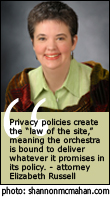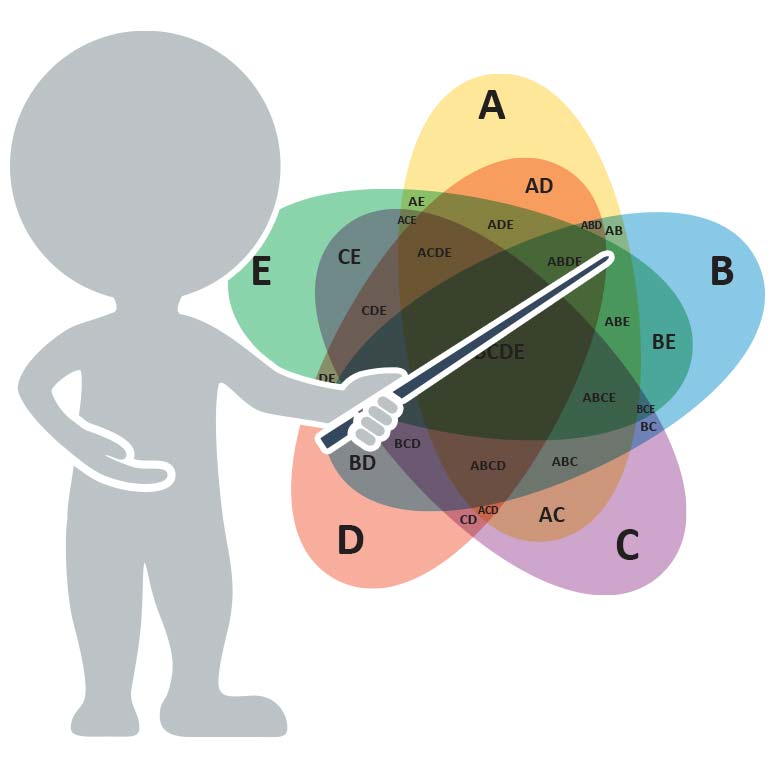Now in its fourth year, the Adaptistration Orchestra Website Review generates a great deal of interest in how each website is evaluated and how orchestras of vastly different budget size can be compared on an even playing field.
This article examines the components of an effective orchestra website, reviews the evaluation criteria in detail, and introduces new features for the 2007 review. As a special feature to the 2007 review, Arts & Entertainment attorney Elizabeth Russell will review what orchestras need to know about three crucial web-related legal issues …
 The evaluation criteria remained mostly unchanged for the 2007 review with the exception of a few refinements and the addition of one new sub-category in the Content & Functionality category: Legal Notices. One enhancement from 2006 is the inclusion of a sub-component in the Education Programs sub-category: whether or not the website provided downloadable resources for teachers and parents such as teaching guides.
The evaluation criteria remained mostly unchanged for the 2007 review with the exception of a few refinements and the addition of one new sub-category in the Content & Functionality category: Legal Notices. One enhancement from 2006 is the inclusion of a sub-component in the Education Programs sub-category: whether or not the website provided downloadable resources for teachers and parents such as teaching guides.
Additionally, every manager will benefit from the redesigned review survey which produced a far more comprehensive set of data over last year’s surveys (which will be published on Wednesday, 9/19/2007).
The new Legal Notices sub-category included such items as copyright notices and website developer information as well as links to terms of use and privacy policy information.
In order to better understand the importance of web-related legal issues for orchestras, Elizabeth Russell, a Madison, WI based Arts & Entertainment attorney concentrating in copyright, trademark and internet issues, was kind enough to summarize these crucial issues in three easy-to-remember points:
- Limiting their own liability for third party content.
This is easily addressed by following guidelines set forth in the Digital Millennium Copyright Act (DMCA). Unfortunately, most orchestras fail to take these critical steps. The orchestra must post a policy that contains elements required by the DMCA; it must follow and implement the policy; and the orchestra must designate an agent with the US copyright office to receive complaints of infringement. - Paying very close attention to their privacy policy language.
Privacy policies create the “law of the site,” meaning the orchestra is bound to deliver whatever it promises in its policy. One common error is being overly broad and ultimately being unable to follow through on claims such as “we’ll never share your information with anyone.” Orchestras should make sure their data collection mechanisms comply with state and federal privacy laws; they should also have a plan in place to respond swiftly and appropriately in the event of any “data spills.” - A current copyright notice should appear not only in the footer of every page but in the website’s metatags.
The orchestra should also register the content of its site with the US copyright office. Even though copyright “attached” when they put the material into a fixed form, the orchestra can’t take action against infringement until it registers the content with the copyright office. Orchestras should put notices in their planning calendar to register their site every quarter.
Finally, 2007 welcomes five new orchestras to the review: Florida West Coast Symphony, Fresno Philharmonic, Long Island Philharmonic, Symphony Silicon Valley, and the Wisconsin Chamber Orchestra. All of these ensembles crossed over the minimum requirements a professional orchestra must meet in order to be included in the review.
Evaluation Criteria
 In order to adequately examine an orchestra website it is useful to examine exactly what factors contribute to an effective offering. At the core of every good orchestra website is the ability to generate revenue and create awareness in a way which is more efficient than traditional methods orchestras currently employ. The diagram to the right (click to enlarge) illustrates how an orchestra website should be designed: a core function supported by five primary components which are delivered in an outer cover of straightforward functionality.
In order to adequately examine an orchestra website it is useful to examine exactly what factors contribute to an effective offering. At the core of every good orchestra website is the ability to generate revenue and create awareness in a way which is more efficient than traditional methods orchestras currently employ. The diagram to the right (click to enlarge) illustrates how an orchestra website should be designed: a core function supported by five primary components which are delivered in an outer cover of straightforward functionality.
When orchestra websites are examined from this perspective it becomes a straightforward process to identify the key components for each section. As such, whether or not an orchestra has a budget that accommodates professional graphic design and photography to create an aesthetic web signature isn’t as important as designing a website that allows users to easily absorb crucial information.
As a result, the websites were not examined on the subjective basis of color schemes, layout, graphics, or other aesthetic qualities so long as those issues did not have a negative impact on basic functionality and performance. Consequently, this allows orchestras of varying budget size to be evaluated on an even playing field.
Orchestras were graded on five categories, each with multiple sub-categories:
Category 1: Performance Schedule – 20 points maximum
- Patrons need to be able to log onto an orchestra’s website and be able to gather information about the latest performances as well as upcoming events directly from the home page.
- This category contains two sub-categories which covered layout & organization features as well as monthly concert schedule displayed in a calendar style navigation.
Category 2: Purchasing Tickets – 20 points maximum
- In addition to being able to find concert information quickly, patrons also need to be able to securely complete a ticket purchase for any given performance in no more than five minutes.
- This category contains six sub-categories covering features such as single ticket and subscription sales, ability to select seating, box office information, and secure purchasing options.
Category 3: Orchestra Information – 20 points maximum
- Learning about an orchestra and having easy access to contact information and educational program information is crucial to an orchestra’s ability to establish meaningful connections with its community.
- Given the fact that orchestras are suffering from wholesale underexposure, providing ample access to PR materials that can be accessed by media representatives 24 hours is crucial to maximizing exposure.
- This category contains seven sub-categories covering biographical and contact information for music directors and musicians. Staff and board listings with related individual contact info were also considered essential. Educational offerings which included downloadable resources for teachers and parents as well as dedicated education sites assured the highest score possible in that sub-category.
Category 4: Making Donations – 20 points maximum
- There isn’t a professional orchestra in the U.S. that doesn’t need donations. As such, encouraging patrons to donate online to a variety of programs is a crucial component for every orchestra website.
- This category contains two sub-categories addressing issues such as providing secure commerce servers and a variety of one time and preplanned giving options.
Category 5: Content & Functionality – 20 points maximum
- If patrons can’t find your website then it won’t really matter how nice of a site you develop. Orchestras need to be able to present large amounts of information and e-commerce solutions to their patrons without overloading them or making it difficult to find what they need. Accuracy, current information, uniqueness of offerings, and providing institutional transparency documents all play an important role in this category.
- This category contains six sub-categories covering issues such as URL clarity to navigation structure to site performance.


